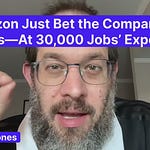Right now, in 2025, we stand at the epicenter of an AI revolution, an era brimming with both promise and overwhelming competition. Blah blah blah. You’ve heard it all before.
But a lot of us—we still believe the dreams just a tiny bit, don’t we?
Most of the folks I have spoken with who are interested in AI and tech have dreams of landing at OpenAI, Anthropic, or one of the tech giants. The lights are bright, indeed. And maybe your dreams are passive (if Sam calls me) and maybe they’re active (I’m applying now), but the point either way is that the bright lights on the main strip of AI have soaked up too much of our collective attention for too long, particularly around jobs.
But here’s the harsh reality: those big names are probably not your best bet. Not because you’re not qualified, but because these giants are trading at sky-high valuations where equity upside has drastically shrunk, and your chance to truly capitalize is limited. The real treasure trove of life-changing opportunities is still out there, but it lies hidden—waiting to be discovered in vibrant, growth-stage startups at the Series A sweet spot.
Why make this guide now? Well, it’s not lost on me that last night (July 8th) we had another SOTA (State of the Art) model release with Grok 4. I expect plenty of talk this week about work and jobs and what AI can do. I wrote about it here.
I honestly think the hardest hitting consequence of the AI revolution is to upend the traditional application structure of the job market. Every resume is perfect. With Cluely, remote interviews are increasingly perfect, except maybe for vibes. It is hard to read a person, and interviewers are pushing harder and harder to flip the script on candidates. Adding surprise questions. Moving to in-person.
The bottom line is the bulk application approach is lower and lower yield these days and we all know it. I’m here to suggest that maybe it’s time to stop following the crowd into diminishing returns. Instead, you need to embrace a smarter, more targeted approach—what is called by me (and others) spearfishing. Unlike spraying hundreds of resumes into the void, spearfishing teaches you to deeply research a handful of promising companies, build tangible, high-impact artifacts that showcase your skills, and craft tailored cold emails that genuinely resonate with hiring managers.
Imagine fixing an actual bug in a company’s open-source repository or building a custom dashboard that solves their pressing challenges before they even interview you. No, you don’t have to be a 10x engineer to do these things. Heck, non-engineers can build dashboards these days.
Think about sending strategic emails that demonstrate immediate value, clearly quantifying the impact of your contributions. Picture confidently navigating interviews with compelling, tailored stories that reflect the specific stage and needs of Series A startups. This isn’t hypothetical—it’s a proven, methodical approach that has consistently turned job seekers into standout candidates.
And it’s not because it’s magic. It’s because it shows passion. And passion is a currency that spends real well in 2025. I’m long human passion in a world of AI. It’s what underlies this entire approach.
This guide matters deeply, right now, because it recognizes the hidden job market—the 70% of AI roles that never see public postings, filled quietly through networks, referrals, and proactive outreach. It offers you the detailed playbook—complete with artifact creation, outreach timing, and pipeline management—to tap into these unseen opportunities and truly differentiate yourself in a fiercely competitive landscape.
In short, this isn’t just about getting hired—it’s about dramatically reshaping your career trajectory. Your equity stake in these smaller, fast-growing startups can (sometimes) grow 10-50x, your impact can be immediate and visible, and your learning curve is off the charts. This guide arms you with everything you need if you really want to go after that world: from the critical questions to ask in interviews, to the systematic way to discover and approach the best AI companies before everyone else. And yes I’ll underline it again—there is some coding stuff in here but it is not just for engineers! The examples really do work for anyone willing to wrestle a bit with vibe coding and a passion for a business.
So maybe it’s time to stop chasing diminishing returns in big gigantic tech brand names. It’s time to aim with precision, deliver unmistakable value, and really target the role that can genuinely change your life. The tools, strategies, and mindset laid out here aren’t just good advice—they’re best practice tempered by the strong opinions I’ve developed shepherding hundreds of people through job searches in the past couple of years, and I am sharing them here for the first time.
Jobs are really annoyingly high leverage as far as our future life trajectories go, so it’s not an exaggeration to say that putting the time in and really executing on these tips could be a career-altering opportunity waiting for you to seize, today.
Ugh I know, so dramatic. But still true! Enjoy the read, and happy spearfishing…
Listen to this episode with a 7-day free trial
Subscribe to Nate’s Substack to listen to this post and get 7 days of free access to the full post archives.















